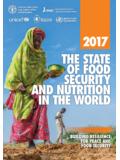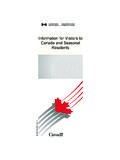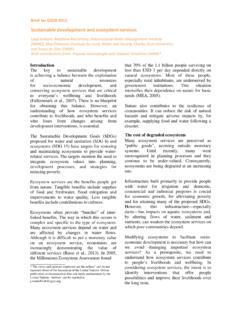Transcription of Population and Security: How Demographic …
1 _____ Journal of International Affairs, Fall 2002, vol. 56, no. 1. The Trustees of Columbia University in the City of New York. Population and security : How Demographic Change Can Lead to Violent Conflict JACK A. GOLDSTONE _____ While the marked decrease in Population growth in many countries and regions is good news for those concerned about global Population , it offers no clear relief for concerns about the security implications of Population change. _____ s we cross into the new century, the world seems finally to have turned the corner on Population growth. A combination of increased education for women, national and international support for policies of Population planning and the spread of economic development and accompanying movement along the Demographic transition frontier have led to falling Population growth rates around the world. Whether among the behemoths China and India or among the smaller but rapidly growing nations such as Saudi Arabia, Kenya and Malawi Population growth rates have dropped dramatically in the last Yet while Population growth rates have dropped around the world, they remain high in some areas.
2 In particular, many nations in the Middle East, southeast Asia and central and northern Africa still are growing at nearly 3 percent per year, a growth rate that leads to a doubling of Population in approximately 25 years. Moreover, although in most countries the rate of Population growth has slowed, the absolute number of people being added to the world s Population has not; the APopulation and security FALL 2002 | 4large number of women of childbearing age in the developing world, carrying the momentum of past Population growth, ensure that even while growth rates fall as a percentage of the existing Population , the number of new births each year continues to rise. For example, although China s growth rate has fallen to percent per year, China will still grow by 10 to 11 million people per year for the next 15 years. The world as a whole will add roughly 80 million people per year, or another 960 million (that is, another India) in the next dozen DEMOGRAPHY AND security : KEY FINDINGS After nearly three decades of debate and analysis, stemming from Myron Weiner s (1971) path-breaking study, scholars are beginning to develop much clearer answers to the complex questions regarding how Population changes affect security concerns.
3 Those answers can be summarized briefly in the following propositions, each of which we shall treat in greater detail below: 1) While Population growth often brings degradation of forests, water resources, arable land and other local resources, such environmental degradation is not a major or pervasive cause of international wars, ethnic wars or revolutionary conflicts. Such degradation often brings misery, yet such misery does not generally trigger the elite alienation and opposition to the government necessary for large-scale violence to occur. 2) Population growth can give rise to conflicts over increasingly scarce resources, such as farmland, if those conflicts involve elites seeking to take resources from popular groups, or competition between elite factions for control of those resources. However, what determines whether violent conflict arises are the relationships among popular groups, elites and the state, and particularly whether the state has the capacity to channel and moderate elite conflicts.
4 Only where elite conflicts or popular resistance to elite actions overwhelm weak states do major conflicts arise. 3) While overall Population growth and Population density do not generally predict political risks, a number of distinct Population and security FALL 2002 | 5kinds of Demographic changes rapid growth in the labor force in slow-growing economies, a rapid increase in educated youth aspiring to elite positions when such positions are scarce, unequal Population growth rates between different ethnic groups, urbanization that exceeds employment growth and migrations that change the local balance among major ethnic groups do appear to increase the risks of violent internal political and ethnic conflicts. In addition, there is some evidence that countries with larger populations have greater risks of both armed conflict and state repression. 4) Most Population changes do not directly increase the risks of international wars between domestically stable states; however, because many international wars have their origins in domestic conflicts ( , the Iran/Iraq war growing out of Iran s revolution; international wars in West and Central Africa growing out of the collapses of Liberia, Sierra Leone and Congo/Zaire), in those contexts where Population changes produce domestic political crises, the risk of international war is also increased.
5 There is also some evidence that the intensity of war, in terms of casualties, increases in countries with exceptionally large youth cohorts. 5) Certain Demographic changes, such as a rise in infant mortality aside from whatever role they may have as causes can be powerful indicators of coming political violence. 6) Rapid and large-scale Demographic changes, such as a rise in mortality or a sharp rise in migration, can arise as an outcome of violent conflicts. THE ENVIRONMENT AS A CAUSE OF VIOLENT CONFLICTS Thomas Homer-Dixon provoked a great deal of controversy and concern with his claim that we are on the threshold of an era in which armed conflicts will arise with increasing frequency as a result of environmental However, in the years since his warning, the search for evidence behind this claim has provided little support. As Paul Diehl has remarked, the many publications from the [Toronto] project have produced largely abstract conceptions of the environment-conflict nexus, with Population and security FALL 2002 | 6actual cases presented only as anecdotal evidence or as illustrative examples.
6 Iv After nearly a decade of research, it now seems clear that long-term environmental degradation of the kind that often accompanies development ( , soil erosion, deforestation and air and water pollution) has little or no significant role in generating civil or international Detailed cross-national studies have found only very weak relations between environmental degradation and either international or domestic armed In most studies that make an effort to measure the relative impact of environmental and other causes, environmental factors emerge as less important in determining the incidence of civil conflict than economic and political factors. vii For example, Wenche Hauge and Tanja Ellingsen, in the most comprehensive global test of the environmental-scarcity-leads-to-violence hypothesis with recent data (1980 92), found that while deforestation, land degradation and low freshwater availability were positively correlated with the incidence of civil war and armed conflict, the magnitude of their effects was tiny.
7 By themselves, these factors raised the probability of civil war by to under These factors did have a slightly higher impact on the probability of lesser kinds of armed conflict (causing increases in the chances of such conflict by from 4 percent to 8 percent); but their influence paled compared to the impact of such traditional risk factors as poverty, regime type and current and prior political instability. In addition, G nther Baechler s extensive study of the relationships between environmental change and violent conflict found that while environmental degradation could be a background or triggering factor in ethnic or political conflicts, most such conflicts were local and peacefully resolved by government regulation or negotiations. Whether or not such conflicts pass[ed] the threshold of violence definitely depends on sociopolitical factors and not on the degree of environmental degradation as such.
8 Ix A third study, undertaken by an academic Task Force on State Failure sponsored by the US government,x deliberately Population and security FALL 2002 | 7sought environmental causes for a wide range of violent conflict events, including authoritarian coups, revolutionary wars, ethnic wars and genocides. However, after adjusting for the impact of living standards, regime type and involvement in international trade, no direct impact of environmental variables could be found. It must be admitted that the range and quality of data on environmental change leaves much to be desired, and the poverty of such data may be one reason for these negative findings. Still, if environmental change were truly a major and pervasive cause of violent conflicts, it seems likely that some large cross-national studies of recent political violence would show more positive findings. Should we therefore dismiss the environment as a cause of conflict?
9 No, although I believe we can be free of the fear that environmental decay will unleash wars and revolutions across the globe. Rather, what research has shown is that although environmental issues do cause international and domestic conflicts, they are of the kind that are generally settled by negotiation and compromise and do not lead to taking up arms. The reason for that is straightforward. Where the problem faced by two groups, or two nations, is over the degradation or depletion of an environmental resource, war neither solves the problem (it cannot make more of the resource) nor is it an economically efficient way to redistribute the resource (the costs of war almost invariably far outweigh the cost of gaining alternative resources or paying more for a share of the resource). For example, if two nations have a conflict over sharing river water such as India and Bangladesh over the Ganges,xi Israel and Jordan over the river Jordanxii or Hungary and Slovakia over the Danubexiii they may threaten violence but in fact are most likely to produce non-violent resolution through negotiation or arbitration rather than war (and indeed all of these conflicts led to treaties or international arbitrationxiv).
10 The reason is that for one party to insist on all the water would in fact be a casus belli; and to risk a war to simply increase one s access to water is economically foolhardy. Throughout the world, the main use of Population and security FALL 2002 | 8freshwater (over three-quarters) is for irrigation to produce food . A reduction in water can be compensated either by adopting more efficient means of irrigation (drip rather than ditch); by switching to less water-intensive crops (dry grains rather than rice; tree crops rather than grains); or by importing food rather than producing it. All of these steps, though costly, are far, far, less costly than armed conflict. Thus for both the country with the ability to take more water and the country dependent on downstream flows, the issue will be how to use and negotiate use of the resource most efficiently; resort to war would inevitably be more costly than any gains that could be made from increased access to the resource.









